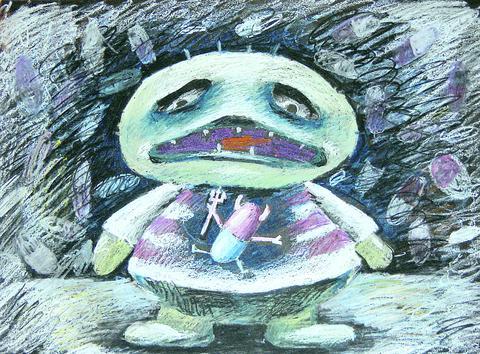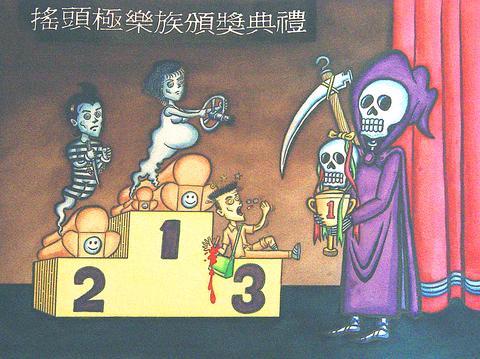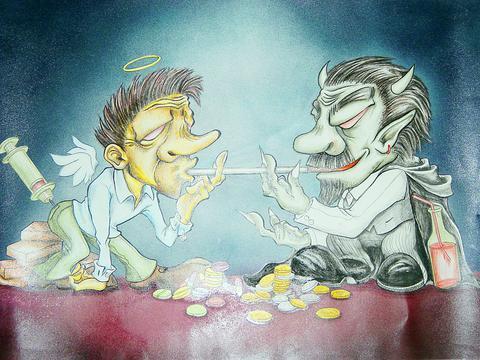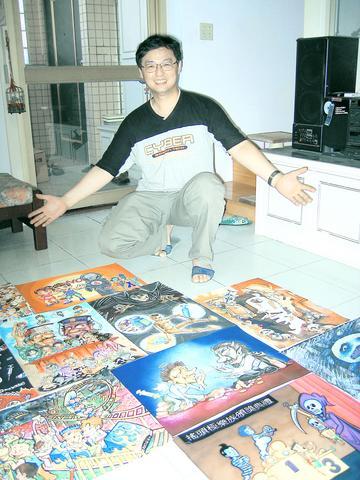Taiwan's drug education and awareness programs got a new look earlier this week, when the results of the Chinese Cartoonists' Union's (CCU,
Attracting over 800 entrants from across Taiwan, the contest's dozen winning works are set to become the new face of the government's anti-drug programs. Posters of the winning works will be hung in public places, as well as adorning anti-drug paraphernalia and booklets.
The idea was the brainchild of Yang Hsin-i (楊心怡), the CCU president and an editorial cartoonist with a prominent Chinese-language daily and the contest was organized by the union and received financial backing from the Department of Health's (行政院衛生署) National Bureau of Controlled Drugs (NBCD,

PHOTO: GAVIN PHIPPS, TAIPEI TIMES
"The idea came from constantly seeing front page photographs of hundreds of youngsters picked up by police in raids at pubs and nightclubs," explained the Yang. "I mean, when there's over 500 people picked up from one nightclub alone then there's obviously something wrong with the governments' anti-drugs message. I figured it needed a fresh face."
Founded three years ago by a group of cartoonists, the CCU's aim is to promote understanding and augment the quality of editorial cartoons in Taiwan.
Since being founded in 2000 the union has not only been busy on the local scene (it now boasts 100 members) but it has also managed to attract the attention of foreign cartoonists. With very little promotion the CCU's inaugural Taiwan International Cartoon Contest (

COURTESY OF THE CHINESE CARTOONISTS UNION
Unlike last year's competition, the recent Youth Anti-Drug Cartoon Contest was an amateur affair aimed at Taiwan's youth. Along with posting the information on its Web site, the CCU was aided in its efforts to attract contestants by the NBCD.
The government body contributed funds as well as endorsing the competition, in conjunction with the drug awareness programs that run in many of the nation's schools.
"We are always looking for new and inventive ways to get the anti-drug message across and cartoons are a great way to do this," said the NBCD's Li Chia-chi (

COURTESY OF CHINESE CARTOONISTS UNION
Although the NBCD inter-school/college programs attracted large numbers of contestants, the CCU's popular Web site also played a big part. Updated regularly with the latest cartoons by a string of well-known local editorial cartoonists, the site is popular amongst students and aspiring cartoonists, such as 18 year-old Changhua native Wu Shuan-chen (吳璇真).
"I read about the contest on the Internet and figured why not enter? After all, it's a worthwhile cause," said the 18-year-old, whose work Exchange of Death, which depicts a chap sharing a joint with the Devil, gained her third place in the contest's senior high school category. "I've never taken drugs, so I did quite a bit of research concerning the cause and effects of drug use on the Web."
Considered an editorial cartoon competition -- a concept that very few adults have an inkling of, let alone school children -- rather than one that asked for artwork to be tendered, Yang and fellow CCU members were initially skeptical about the quality of works that would possibly be

PHOTO: GAVIN PHIPPS, TAIPEI TIMES
submitted.
The union's apprehension, however, was proven wrong. Many of the works were considered by the CCU-resident and the 10-man judging panel to be of exceptional quality. Possessing both a colorful array of styles and, more importantly for the judges, a clear editorial cartoon-styled message.
"It was a cartoon competition and the point about editorial-styled cartoons is, of course, the message. In many of the works we looked at the anti-drugs message was very clear," said CCU member Lin Shi-jun (
Divided into four categories -- junior high, senior high, young adult/college and animation -- the union received a total of 857 entries by the contest's cut-off period in late June. The top 77 of these will appear in a joint CCU/NBCD publication sometime in the coming months and adorn the walls of the Taipei City Central Library in early August.
While cash prizes were awarded to the top three contestants in all four categories, the top prize of NT$50,000 went to Lai Yi-chang's (
Unwelcoming it maybe, but Lai's work is one which Yang feels gets the message across in a straightforward, unglamorous and highly editorialized manner.
"The winning work was fantastic. It had all the qualities we were looking for. It was blunt and to the point, with a clear message, as well as maintaining its cartoon style features," said Yang.
"I'm sure it will work as well, as the piece is very eye-catching. Its hideousness draws the viewer in and it makes no bones about what it is saying."
The standard of many of the works submitted to the competition might have surpassed expectations, but the contest did attract the attention of several oddball entrants. Some contestants, however, didn't seem able to focus on the competition's fine print.
"We got a couple of competitors who missed the point entirely," said Yang with a slight smirk. "They thought the idea was to draw a cartoon of what it's like to be on drugs. Go figure!"

The canonical shot of an East Asian city is a night skyline studded with towering apartment and office buildings, bright with neon and plastic signage, a landscape of energy and modernity. Another classic image is the same city seen from above, in which identical apartment towers march across the city, spilling out over nearby geography, like stylized soldiers colonizing new territory in a board game. Densely populated dynamic conurbations of money, technological innovation and convenience, it is hard to see the cities of East Asia as what they truly are: necropolises. Why is this? The East Asian development model, with

June 16 to June 22 The following flyer appeared on the streets of Hsinchu on June 12, 1895: “Taipei has already fallen to the Japanese barbarians, who have brought great misery to our land and people. We heard that the Japanese occupiers will tax our gardens, our houses, our bodies, and even our chickens, dogs, cows and pigs. They wear their hair wild, carve their teeth, tattoo their foreheads, wear strange clothes and speak a strange language. How can we be ruled by such people?” Posted by civilian militia leader Wu Tang-hsing (吳湯興), it was a call to arms to retake

This is a deeply unsettling period in Taiwan. Uncertainties are everywhere while everyone waits for a small army of other shoes to drop on nearly every front. During challenging times, interesting political changes can happen, yet all three major political parties are beset with scandals, strife and self-inflicted wounds. As the ruling party, the Democratic Progressive Party (DPP) is held accountable for not only the challenges to the party, but also the nation. Taiwan is geopolitically and economically under threat. Domestically, the administration is under siege by the opposition-controlled legislature and growing discontent with what opponents characterize as arrogant, autocratic

When Lisa, 20, laces into her ultra-high heels for her shift at a strip club in Ukraine’s Kharkiv, she knows that aside from dancing, she will have to comfort traumatized soldiers. Since Russia’s 2022 invasion, exhausted troops are the main clientele of the Flash Dancers club in the center of the northeastern city, just 20 kilometers from Russian forces. For some customers, it provides an “escape” from the war, said Valerya Zavatska — a 25-year-old law graduate who runs the club with her mother, an ex-dancer. But many are not there just for the show. They “want to talk about what hurts,” she